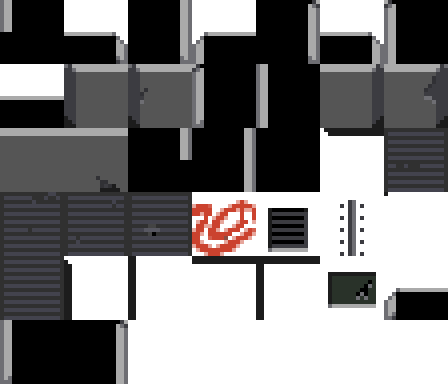Recently, i have been trying to draw a very simple tileset for a grid-based game i started this year.
I write the game in Haxe with Heaps,
and draw the tiles in Aseprite.
My first issue was how to use the tileset with Heaps’s Atlas class.
I draw each tile in a separate .aseprite file,
mostly because i am going to animate some of them and animating the whole tileset is impractical,
but this is not a problem because i can use Aseprite’s command-line interface to generate a single PNG file with all the individual tiles packed in:
aseprite --batch *.aseprite --sheet-pack --sheet tileset.png
It generates something like the following image.

For now, every tile is a static 16 × 16 pixel image, but even so Aseprite most likely will place the tiles on the PNG in a non-predictable position, meaning that i can not know in advance the X and Y coordinates of any tile in the PNG.
To help with that, Aseprite also writes out a JSON-formatted file that has the names, coordinates, and sizes of each tile in the PNG:
{ "frames": {
"floor.aseprite": {
"frame": { "x": 0, "y": 64, "w": 16, "h": 16 },
"rotated": false,
"trimmed": false,
"spriteSourceSize": { "x": 0, "y": 0, "w": 16, "h": 16 },
"sourceSize": { "w": 16, "h": 16 },
"duration": 100
},
"floor-brokenA.aseprite": {
"frame": { "x": 96, "y": 32, "w": 16, "h": 16 },
"rotated": false,
"trimmed": false,
"spriteSourceSize": { "x": 0, "y": 0, "w": 16, "h": 16 },
"sourceSize": { "w": 16, "h": 16 },
"duration": 100
},
…
"wallF.aseprite": {
"frame": { "x": 64, "y": 32, "w": 16, "h": 16 },
"rotated": false,
"trimmed": false,
"spriteSourceSize": { "x": 0, "y": 0, "w": 16, "h": 16 },
"sourceSize": { "w": 16, "h": 16 },
"duration": 100
}
},
"meta": {
"app": "http://www.aseprite.org/",
"version": "1.2.21-x64",
"image": "tileset.png",
"format": "RGBA8888",
"size": { "w": 112, "h": 96 },
"scale": "1"
}
}
Apparently, this format is a kind of de facto standard for spritesheets and Aseprite’s author is not sure where it came from,
possibly from TexturePacker.
Heaps’s Atlas, on the other hand, uses a text file format based on libGDX,
also used by Spine,
and can not directly read Aseprite’s JSON files.
I did not find any tool to convert from Aseprite’s JSON to libGDX’s atlas format,
so i wrote one that serves my purposes.
By default, it reads the file from its standard input because, without the --data parameter, Aseprite writes the JSON to its standard ouput,
therefore i can create both the PNG and the .atlas files in a single line:
aseprite --batch *.aseprite --sheet-pack --sheet tileset.png | jsontoatlas tileset.atlas